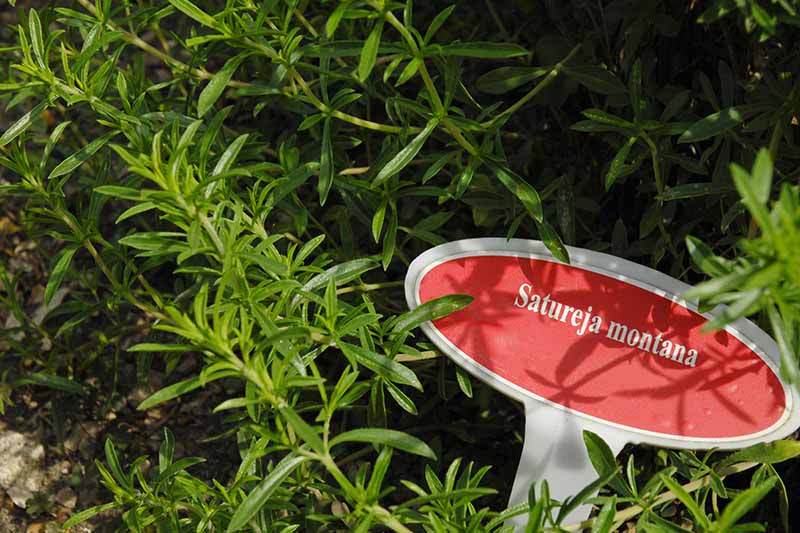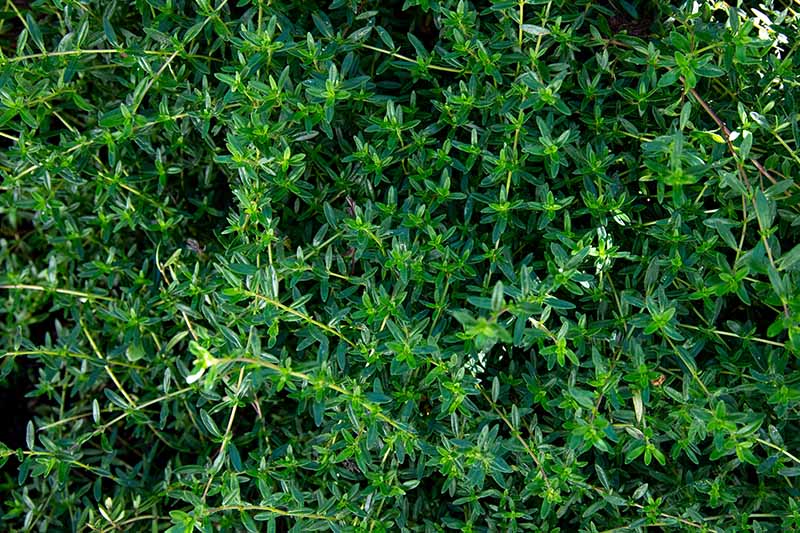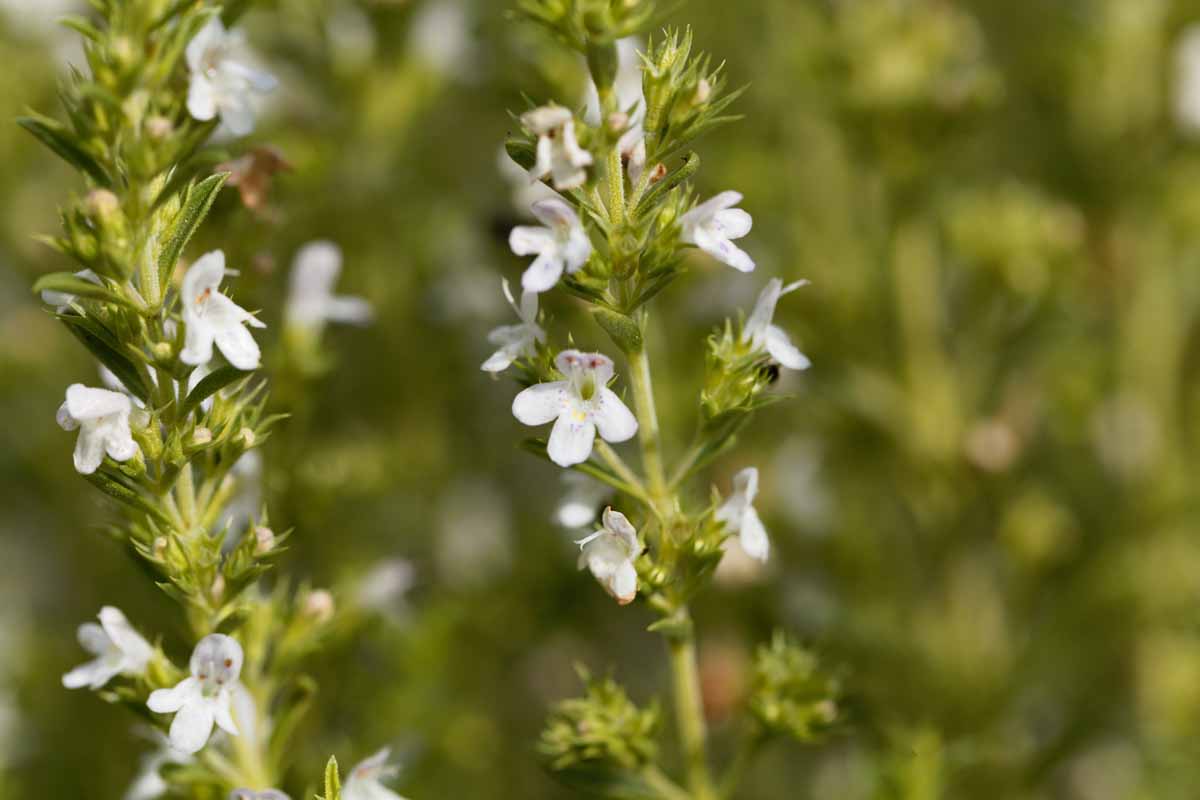How to Plant and Grow Winter Savory
Winter savory is a perennial herb with an intense, peppery flavor that can be enjoyed fresh all year long. Get all the details to grow your own right here.


Satureja montana
Herbs can offer an amazing array of benefits. And winter savory is no exception.
From their intense flavors and fragrances to their uses in the garden attracting pollinators and repelling pests, these plants are beloved by cooks, gardeners, and herbalists alike.
Kitchen herbs like parsley, oregano, rosemary, sage, and thyme are commonly grown in the home garden, but many enthusiasts miss out on the delights of winter savory.


We link to vendors to help you find relevant products. If you buy from one of our links, we may earn a commission.
A perennial evergreen, S. montana has a much longer season than its close cousin summer savory (S. hortensis) – which you can read all about here.
Low maintenance and easy to grow, it’s also a versatile performer in the kitchen – and year-round convenience is what gives S. montana its must-have status in my garden. A freshly picked sprig added to a simmering pot of beans or stew makes a cold winter’s day seem just a little bit warmer!
Let’s dig into the growing details so you can enjoy some yourself.
What You’ll Learn
- What Is Winter Savory?
- Cultivation and History
- Propagation
- How to Grow
- Cultivars to Select
- Managing Pests and Disease
- Companion Planting
- Harvest and Storage
- Best Garden Uses
- Recipes and Cooking Ideas
- Quick Reference Growing Guide
What Is Winter Savory?
An evergreen perennial, winter savory is a low-growing, semi-woody herb in the mint family, Lamiaceae, and is also commonly known as creeping, mountain, or Spanish savory.


Native to the temperate climates of the Mediterranean basin, it forms low growing and multi-branched mounds that grow 8 to 15 inches high, with a 12- to 24-inch spread.
The glossy, 1-inch leaves are dense, slender, slightly leathery, and highly aromatic, appearing opposite on the stems. Small, dainty flowers appear on terminal spikes throughout summer in colors of mauve, pink, and white.
Cold hardy in USDA Hardiness Zones 6-9, these plants go dormant in winter and can lose many of their mature leaves along the stem tips. But new growth quickly appears on the bare stems once longer days and warmer temperatures return.


But there are always plenty of small, year-old stems that retain their leaves throughout the year. These can be picked and enjoyed for winter cooking as needed.
The closely related summer species, S. hortensis, is a fast-growing annual, with a less intense and fresher flavor than S. montana.
Cultivation and History
Aptly named, savory comes from the from the old Latin root word sapor, which became the Old French savoure – for tasty or fragrant. The word za’atar, the name of the popular (and flavorful) Middle Eastern spice mix, also comes from the same root word.


S. montana has a deep, earthy flavor – peppery and piney with a piquant intensity – and has long been used as a seasoning.
Many antiquated texts speak of its use as a seasoning and for its healing properties. It was the Roman poet Virgil who recommended planting it near beehives, and in “The Complete Herbal,” Nicolas Culpeper favors it as a stimulant to “quicken the dull spirits.”
Introduced to Europe by the Romans, medieval walled gardens grew both the summer and winter species, and it was used to stuff meats and poultry.


The Germans discovered that fresh sprigs added to a cooking pot of beans made them easier to digest. Today, it’s still referred to as the “bean herb,” or Bohenkraut in German.
During the economic expansion of the sixteenth and seventeenth centuries, French and English garden designers of the day recommended planting this herb for its fragrance. This was an important component in the new “gardens of delight” that were popular with the nouveau riche.
Winter savory was introduced to the US by European colonists in the 1800s.
Propagation
Winter savory can be propagated by seed or stem cuttings.
From Seed
Sow seeds indoors 4 to 6 weeks before your last frost, sowing lightly on the surface of trays containing a prepared starting medium. Don’t cover them with soil, as they need light to germinate. You should notice seeds sprouting in 10-14 days.
Keep the soil moist but not wet. When the seedlings have at least four sets of true leaves, transplant to containers or the herb garden – provided there’s no risk of frost. Handle gently to reduce transplant shock.
From Stem Cuttings
For propagation via cuttings, take 4- to 6-inch cuttings in spring or fall, and strip the leaves from the bottom 2 inches.
Dip the cut ends into a powdered rooting hormone and place them in small pots of wet sand, or a prepared seed starting mix amended with 1/3 sand.


Once roots have formed, in about 4 to 6 weeks, transplant into the garden or larger containers.
By Division
Root division is also an option, and it’s a good choice for aging container-grown plants that need to be rejuvenated.
In spring, remove plants from their containers and trim away about a third of any wrapped or bound roots.
Divide the root ball into thirds or quarters, ensuring that each section has a healthy piece of root and stems with green leaves attached.
Remove one-third of the top growth, and trim away any dead or damaged stems and leaves.
Replant in containers or directly into the garden. Learn more about dividing perennials here.
How to Grow
S. montana requires a full sun location.


This herb prefers soil with a neutral pH of 6.0-8.0 that is well-draining and moderately fertile.
Enrich the planting soil with a mix of 1/3 organic matter such as aged compost or well-rotted manure, and 1/3 coarse sand or grit to improve drainage.
Choose a site where plants can remain undisturbed, and prepare planting holes 8 to 10 inches apart, twice as wide and a bit deeper than the root balls.
Mix a little bone meal into the planting site to encourage strong, healthy root growth.
Set plants in place and backfill holes with the planting mix, gently firming the soil in place over the roots.
Water lightly and provide regular moisture until established. Once plants are settled, in 4 to 6 weeks, dry to moderate moisture levels are sufficient. Allow the soil to dry out between watering deeply bi-weekly. For container plants, water when the top inch of soil is dry.
Apply a top dressing of organic matter like compost in spring but avoid liquid fertilizers – savory’s flavor is improved when grown in lean soil.
Trim in early spring before new growth emerges, removing last season’s spent seed heads – or approximately 1/3 of overall growth.


Plants are cold hardy to around 10°F. If temperatures in your region regularly dip to this mark, select a sheltered planting site and provide cold insulation during the winter months.
A thick, 4- to 5-inch-thick straw mulch spread over the crown and out to the drip line will help protect against freezing temperatures and drying winds. Remove the mulch in spring.
Older plants can become woody and benefit from regular pruning to encourage new growth and a full, bushy form.
Plants are short-lived and need to be replaced every 4-5 years in the garden, and every 2-4 years if grown in containers.
Indoors
To bring plants indoors for winter, provide a pot measuring at least 12 inches in diameter and with a similar depth.


Use a potting mix amended with 1/3 coarse sand and ensure the soil and pot drain freely.
Place plants in a cool, sunny window with at least 6 hours of light per day. Or, use a full spectrum grow light.
Water lightly when the top inch of soil is dry, and ensure plants are well-spaced in the pot with ample air circulation.
Cultivars to Select
It can be quite difficult to find winter savory in most grocery stores, but some nurseries have seedlings – if they carry an extensive selection of herbs. It is possible to buy plants and seeds online from our trusted affiliates.


Winter Savory Plants
If you want to get a head-start, packages of three winter savory plants are available from Burpee.
Or why not start your own from seed?


Winter Savory Seeds
You can buy packets of seeds in various sizes from True Leaf Market.
Managing Pests and Disease
So easy to care for, S. montana plants have no serious disease problems to report, and most pests tend to avoid it. Leafhoppers, spittlebugs, and spider mites can make occasional appearances, but the damage that they may cause is generally insignificant.
Companion Planting
Winter savory is highly attractive to pollinators like bees, and it’s a natural planted near beehives for the superbly flavored, piney honey produced.


It repels cabbage moths and can be planted with any cruciferous veggies for pest protection.
Planting with beans and onions is said to improve the flavor of both. It also repels bean weevils, and when planted at the base of roses, can reduce infestation of aphids and mildew.
Harvest and Storage
As a perennial, leaves can be picked year-round, although the flavor is typically best during the summer.
Harvest sprigs in the morning, after the dew has dried – this is when their essential oils are most potent and flavorful.
Cut from mature stalks only, leaving at least half of the stalk intact for future growth.
Store the fresh sprigs in a small jar of water until you’re ready to use them, kept out of direct sunlight. Or, place them in the refrigerator where they will stay fresh for 10 to 14 days.
The flavor is best when it’s used fresh, but you can also dry your harvest for longer term storage.


To dry, bundle stems with kitchen twine and hang them in a cool, airy spot out of direct sunlight. Or, place the stems in your food dehydrator at its lowest setting, 95 to 115°F for 1 to 2 hours.
Don’t have a dehydrator? You can learn about the best models from our sister site, Foodal.
Once they are dry, gently strip the leaves from the stems and store whole leaves in an airtight container in a cool, dark cupboard. Stored properly, dried leaves will last 3-4 years.
Read more about drying herbs here.
To retain the best flavor, crush fresh leaves just before using.
Fresh sprigs can also be used to infuse and flavor cooking oils and vinegars.
Best Garden Uses
Winter savory is happy growing in containers, herb or kitchen gardens, and rockeries, or tucked into walls in vertical garden planters.


Because of its tolerance for drought and poor soil, it makes a good choice for rocky banks or slopes. It also makes an aromatic edging plant for beds and borders.
And as an excellent companion, it can be planted liberally in vegetable and flower beds as a pest repellent.
Recipes and Cooking Ideas
In the kitchen, flavorful leaves can be used fresh or dried in numerous recipes, typically to season fish, game, meat, and poultry, as well as in soups, stews, and stuffing.


And it’s delicious added to herb or cheese breads – it’s what gives a spicy tang to Sue’s Savory Muffins, for example. You can find the recipe for these on our sister site, Foodal.
Add fresh sprigs when cooking legumes, like peas and beans, or cabbage, to add flavor and make them more digestible.
Fresh leaves add piquant flavor to compound butters, cooked grains, herbed cheeses, risotto, salads (chicken, green, and potato), salad dressings, vegetables, and vinegars.
Quick Reference Growing Guide
| Plant Type: | Semi-woody herb, perennial | Tolerance: | Deer and rabbit resistant, drought, poor and rocky soil |
| Native to: | Mediterranean Basin and southwest Asia | Water Needs: | Low to moderate |
| Hardiness (USDA Zone): | 6-9 | Maintenance: | Moderate |
| Season: | Evergreen | Soil Type: | Average to lean fertility |
| Exposure: | Full sun | Soil pH: | Neutral, 6.0-8.0 |
| Time to Maturity: | 90 days | Soil Drainage: | Well-draining |
| Spacing: | 12-15 inches | Companion Planting: | Beans, cabbage, onions, roses |
| Planting Depth: | Deep as root ball | Attracts: | Honey bees |
| Height: | 12-15 inches | Family: | Lamiaceae |
| Spread: | 12-24 inches | Genus: | Satureja |
| Pests & Diseases: | No serious pest or disease problems | Species: | montana |
Some Like It Hot
With a few winter savory plants growing in your kitchen garden, you can enjoy its spicy, earthy flavor year-round.
Add it to your bean or cabbage patch or your rose beds to keep pests away, and be sure to plant a few close to paths to enjoy their spicy fragrance in the garden!


Do you folks have any favorite uses for this evergreen herb? Drop us a line in the comments below.
And if you enjoyed this growing guide, here are a few more herbal primers that might interest you:
- How to Grow Bee Balm: Bring Out the Hummingbirds
- How to Grow Horehound
- How to Grow and Use Lemon Balm
- Grow Faassen’s Catmint for Durable Summer Color







